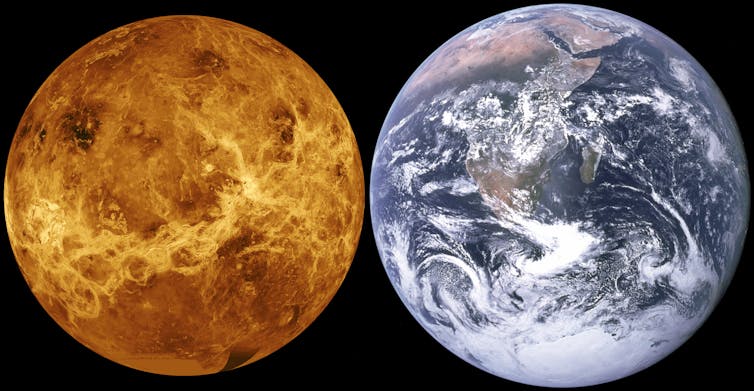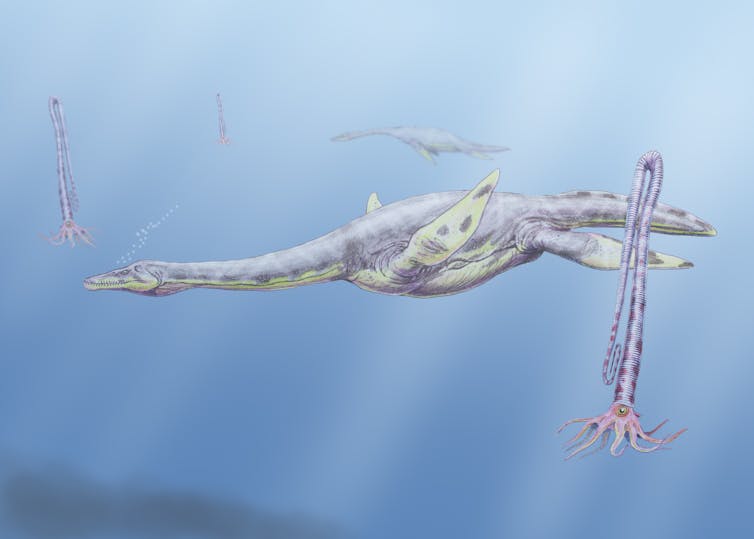December 19, 2018
Unpacking the history of how Earth feeds life, and life changes Earth
Geology has shaped life's emergence on Earth, now there is growing evidence that life has shaped our planet.
At a fleeting glance, the study of life ‚Äď biology ‚Äď seems very separate from that of rocks, or geology.
But a look back through history shows that geological processes have been key to the evolution of life on Earth. Geology has shaped biology by creating favourable conditions, and indeed the basic ‚Äúingredients‚ÄĚ, for life‚Äôs emergence and evolution.
And now there is growing evidence that this also works in reverse: life has shaped our planet’s atmosphere, oceans and landscapes in many ways.
Let’s take a walk back through time.
Read more:
Our planet is a living organism
Early in the 20th century, that living organisms shape their environment in a way that allows life to be sustained. In the 1970s, a similar idea known as the ‚Äú‚ÄĚ emerged in the Western world, thanks to scientists James Lovelock and Lynn Margulis.
Life started shaping the planet as soon as it appeared, possibly as . Back then and without a little help, the whole planet should have remained frozen.
That little help may have come from bacteria producing the heat-trapping gas methane, with significant amounts of this greenhouse gas .
Much later ‚Äď some 200 million years ago ‚Äď a similar relationship happened in reverse. At this time, more complex lifeforms may have prevented a runaway build-up of carbon dioxide in the atmosphere (as seen on Venus) by trapping CO‚āā in the skeleton of marine organisms like plankton. These then later became .

We are made of star dust
The chemical elements that compose our body were ‚Äď we are made of star dust! We share the origin of our atoms with everything around us, including rocks.
But forces deep within planet Earth also shape life.
Weathering of mountains, and continents in general, also delivers essential nutrients to marine lifeforms. One example is , which is released into rivers and oceans by weathering of the mineral apatite found in continental rocks. Phosphorus is also a building element of DNA molecules, and of adenosine triphosphate (), the ‚Äúrechargeable battery‚ÄĚ responsible for energy transfers in our cells.
Read more:
The could have been key to the first oxidation of the atmosphere (called the , about 2.4 billion years ago). By providing essential nutrients like phosphorus, weathering of the first continents would have allowed photosynthetic cyanobacteria that make up stromatolites to thrive and release oxygen into the atmosphere.

The big beast needs the little one
In 2018 that at the start of the Jurassic Period (about 200 million years ago), plankton began to mineralise at greater ocean depths. Plankton produces oxygen as a byproduct of photosynthesis ‚Äď and so, as a result, oxygen began to accumulate in the shallow oceans and reach its present level in the atmosphere.
The increase in atmospheric oxygen to modern levels would have allowed larger organisms to flourish (including the dinosaurs), because they have higher requirements for this element.
So not only is plankton a key piece of the ecological puzzle ‚Äď because so many marine lifeforms depend on it ‚Äď but it also gave the right conditions for the evolution of large marine reptiles.

Read more:
Closing the loop
So the next question is naturally: what allowed plankton to mineralise differently during the Jurassic Period? Perhaps moving tectonic plates.
Between about 300 and 175 million years ago, continental plates were clustered into the supercontinent called Pangea. Plate reconstructions show that large parts of this supercontinent drifted through the tropics between about .
As a result, continents experienced more abundant rainfall and rocks weathered more extensively, releasing to the oceans the elements .
These processes close the loop between biology and geology. Tectonic plates moving into the tropics resulted in large supply of elements, allowing for the emergence of calcareous plankton, and this plankton in turn was responsible for the last major rise in atmospheric oxygen.
Read more:
Humans are increasingly aware that they have shaped the planet to an unprecedented extent due to the emission of greenhouse gases linked to , and to the advent of the Agricultural Revolution some .
Cyanobacteria, vascular plants and plankton have also modified the whole chemistry of Earth’s atmosphere well before humankind, over much longer time scales.
However, there are striking differences between Homo sapiens on the one hand, and plankton and plants on the other. Humans are shaping the planet in a way that may eventually send the species itself into oblivion ().
Our species is most likely the first to have the abilities to recognise and mitigate its impact on the environment on which it depends.![]()
, Associate Professor, ; , PhD Candidate, , and , ARC DECRA Fellow and Lecturer,
This article is republished from under a Creative Commons license. Read the .
UOW academics exercise academic freedom by providing expert commentary, opinion and analysis on a range of ongoing social issues and current affairs. This expert commentary reflects the views of those individual academics and does not necessarily reflect the views or policy positions of the 51≤ŤĻ›.
:format(jpg)/prod01/channel_3/assets/live-migration/www/images/content/groups/public/web/media/documents/mm/uow254858.jpg)